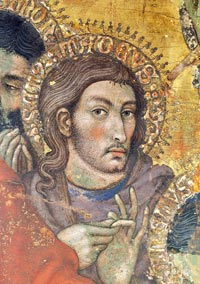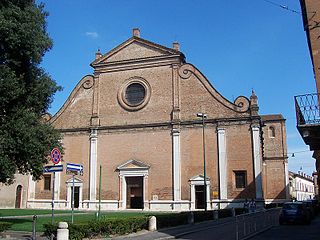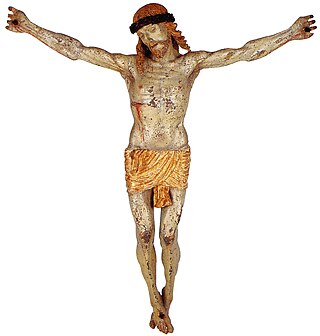Giuseppe Tortelli (1662- circa 1738) was an Italian painter of the late Baroque period, active in Brescia.


Giuseppe Tortelli (1662- circa 1738) was an Italian painter of the late Baroque period, active in Brescia.


He received a broad education in writing and philosophy. He traveled to Naples to observe masters there, then to Venice.
In 1708, he painted two large canvases, depicting the Assumption of Mary and Saints Faustino and Giovita in Adoration of the Cross for the Duomo Vecchio, but now in Duomo Nuovo of Brescia. In 1709, he lost a commission to Andrea Celesti to paint for the Duomo of Verolanuova. He painted a San Liborio (1711) for the Duomo Vecchio, also transferred to the Duomo Nuovo. He painted three scenes of the Passion of Christ (1712) for a via cruces in the chapel of the Santissimi Sacramento of Sant'Agata in Brescia; a Madonna con St Alberto Carmelitano (1721) for the church of the Carmine; a St Matthew and the Angel (1726) for Santa Maria della Carità ; an altarpiece of Christ appears to Saints Pellegrino Laziosi, and Giuliano Confalonieri (1735) for Sant'Alessandro ; an altarpiece depicting Santi Nicola da Bari, Sebastiano, e Rocco (1737) for the sacristy of the parish of Orzivecchi; an altarpiece of Martyrdon of St Erasmus (1738) for San Zeno al Foro; and a Holy Trinity (1738) for San Francesco. [1] In Brescia in the church of San Pietro in Oliveto, the altarpiece in the second altar on the left, depicting St John of the Cross in Contemplation, is attributed to him. [2] he painted a series of eight Saints for the Oratory of the Disciplini, Ostiano, province of Cremona.
Giuseppe Zola was one of his pupils.

Sebastiano Conca was an Italian painter.

Alessandro Bonvicino, more commonly known as Moretto, or in Italian Il Moretto da Brescia, was an Italian Renaissance painter from Brescia, where he also mostly worked. His dated works span the period from 1524 to 1554, but he was already described as a master in 1516. He was mainly a painter of altarpieces that tend towards sedateness, mostly for churches in and around Brescia, but also in Bergamo, Milan, Verona, and Asola; many remain in the churches they were painted for. The majority of these are on canvas, but a considerable number, including some large pieces, are created on wood panels. There are only a few surviving drawings from the artist.

Giovanni Lanfranco was an Italian painter of the Baroque period.

Taddeo di Bartolo, also known as Taddeo Bartoli, was an Italian painter of the Sienese School during the early Renaissance. His biography appears in the Vite of Giorgio Vasari, who claims that Taddeo was the uncle of Domenico di Bartolo.

The Church and Convent of the Girolamini or Gerolamini is a church and ecclesiastical complex in Naples, Italy. It is located directly across from the Cathedral of Naples on via Duomo. The facade is across the homonymous piazza and street from Santa Maria della Colonna. It is one block west of Via Duomo.

Piermaria Bagnadore, also called Pietro Maria Bagnatori, was an Italian painter, sculptor, and architect of the late-Renaissance period.

Giovanni Giacomo Barbelli was an Italian painter of the Baroque period, active in Lombardy. He was a canvas and fresco painter known for his religious and mythological scenes that decorated many churches and residences in Lombardy. He was a highly skilled draughtsman and a brilliant colorist. His work shows an inventive imagination and a thorough knowledge of perspective.
Luca Mombello was an Italian painter of the late-Renaissance periods, mainly active in Brescia.

Jacopo Zoboli, also known by Giacomo, was an Italian painter of the Baroque style.

The Church of San Marco in San Girolamo is a baroque parish church in Vicenza, northern Italy, built in the 18th century by the Discalced Carmelites. It houses various artworks by artists of the early 18th century from Veneto. The sacristy preserves its original furniture of the same period.

The Chiesa della Santissima Trinità dei Pellegrini is a Roman Catholic church located on Via dei Pettinari #36 In the rione of Regola of central Rome, Italy. It stands a block away from the Palazzo Spada on Via Capo di Ferro, while a few blocks away on the Via dei Pettinari stands the Ponte Sisto.

San Zeno al Foro is a church in center of the city of Brescia, situated in Piazza del Foro on the Via dei Musei, a few yards from the ruins of the Roman Capitoline temple in the city.

The church of Santa Maria delle Grazie in Brescia is located on at the west end of Via Elia Capriolo, where it intersects with the Via delle Grazie. Built in the 16th century and remodeled in the 17th century, it still retains much of its artwork by major regional artists, including one of its three canvases by Moretto. The other two are now held at the Pinacoteca Tosio Martinengo. The interior is richly decorated in Baroque fashion. Adjacent to the church is the Sanctuary of Santa Maria delle Grazie, a neo-gothic work.

The Duomo Nuovo or New Cathedral is the largest Catholic church in Brescia, Italy.

The Duomo Vecchio or Old Cathedral is a Roman Catholic church in Brescia, Italy; the rustic circular Romanesque co-cathedral stands next to the Duomo Nuovo of Brescia. It is officially known as the Winter Co-Cathedral of Santa Maria Assunta, while the adjacent main cathedral is known as the Summer Cathedral.

San Francesco is a late-Renaissance, Roman Catholic minor basilica church located on via Terranuova in Ferrara, Emilia-Romagna, Italy.

San Pietro in Oliveto is a Roman Catholic church located at the end of via del Castello in central Brescia, region of Lombardy, Italy.

The Monastery of San Paolo d'Argon was a Benedictine monastery, with convent and church, in the town of San Paolo d'Argon, in the province of Bergamo, region of Lombardy, Italy. It was decorated by premier painters of the late-Baroque era.
Antonio Carneo (1637–1692) was an Italian painter, active in Friuli and Venice, and depicting both mythologic, allegoric, and religious canvases, as well as portraits.

Maffeo Olivieri was an Italian sculptor and wood carver. Often associated with his younger brother Andrea, he was active in Lombardy, Venice and Trentino. He was known for his bronze, wood and marble creations, and considered the premier sculptor in early sixteenth century Brescia.